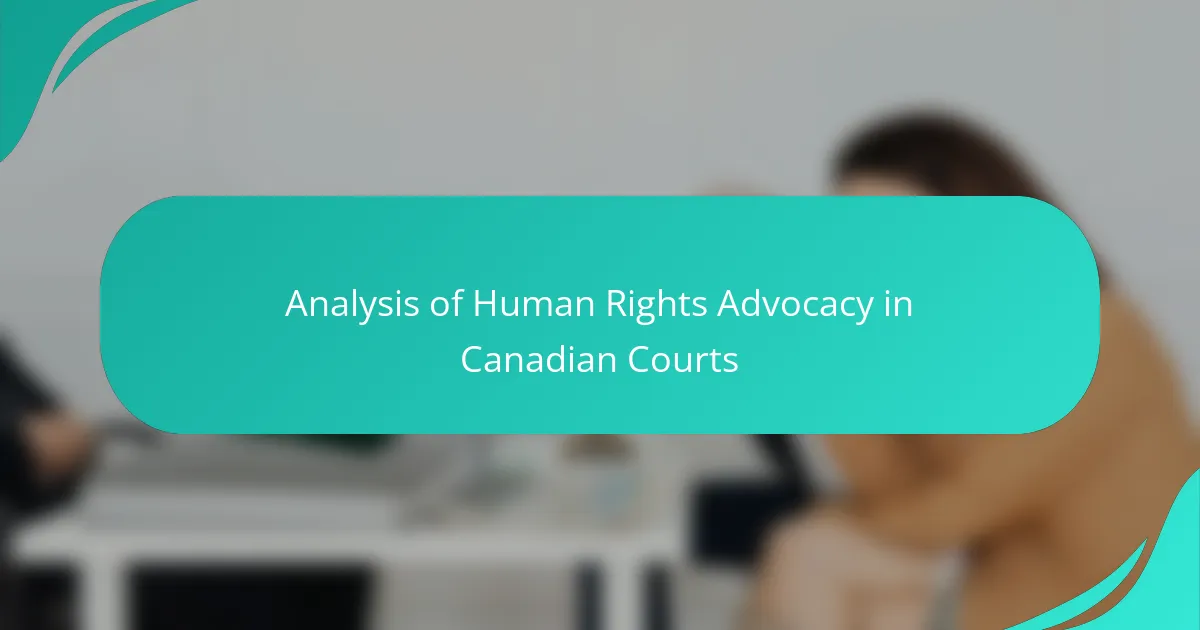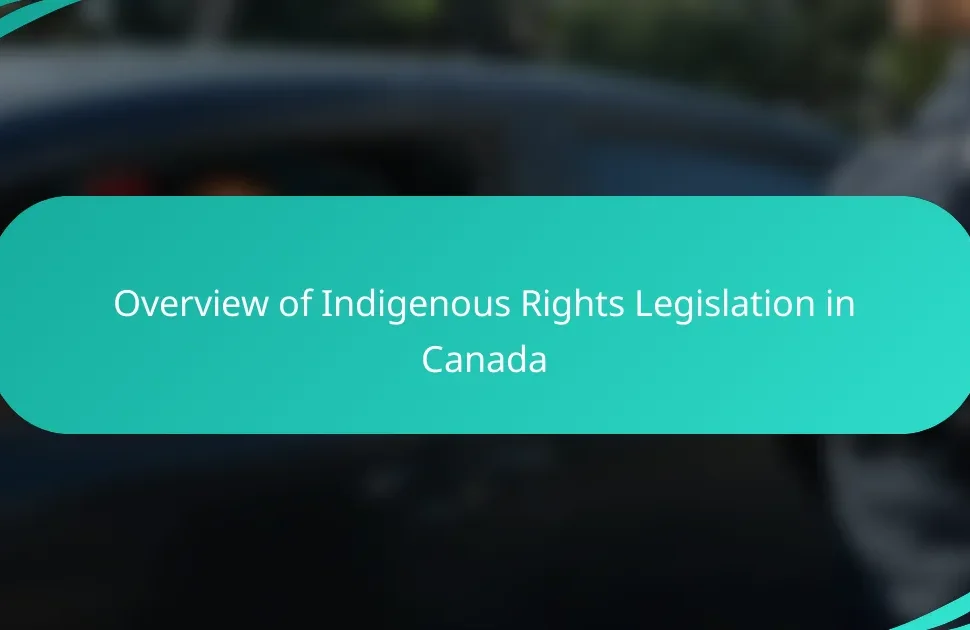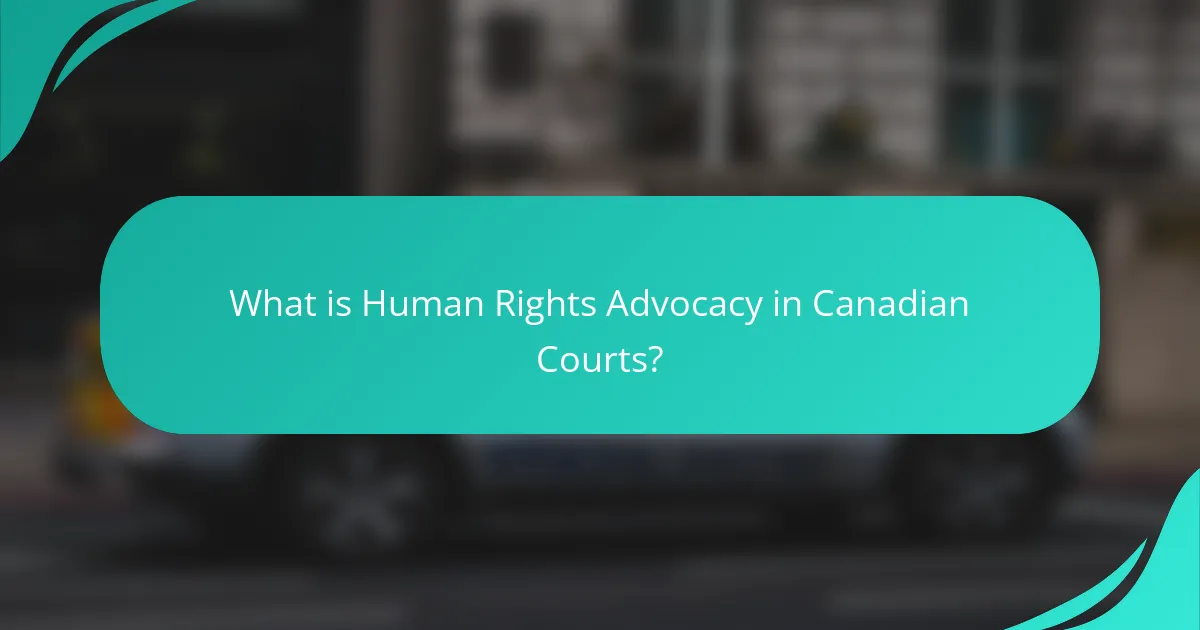
What is Human Rights Advocacy in Canadian Courts?
Human rights advocacy in Canadian courts involves the legal efforts to protect and promote individual rights and freedoms. This advocacy seeks to address violations of rights as outlined in the Canadian Charter of Rights and Freedoms. Lawyers, activists, and organizations participate in this process by bringing cases before the courts. They aim to challenge laws or actions that infringe on human rights. The courts interpret and enforce these rights, ensuring compliance with constitutional standards. Landmark cases, such as R v. Oakes and Eldridge v. British Columbia (Attorney General), illustrate the impact of such advocacy. These cases have shaped the legal landscape by reinforcing protections for marginalized groups. Overall, human rights advocacy plays a crucial role in advancing justice and equality in Canada.
How has Human Rights Advocacy evolved in Canada?
Human rights advocacy in Canada has evolved significantly since the mid-20th century. Initially, it focused on civil liberties and anti-discrimination. The Canadian Bill of Rights was enacted in 1960, marking a crucial step in formalizing human rights protections. The Constitution Act of 1982 further entrenched these rights through the Canadian Charter of Rights and Freedoms. This charter provided a legal framework for challenging injustices in courts.
Over the years, advocacy has expanded to include issues such as Indigenous rights, gender equality, and [censured] rights. Landmark cases have shaped legal precedents, enhancing protections for marginalized groups. Organizations like the Canadian Human Rights Commission have played vital roles in promoting awareness and enforcement.
In recent years, there has been a growing emphasis on intersectionality in human rights advocacy. This recognizes that individuals may face multiple forms of discrimination simultaneously. As a result, advocacy efforts have become more inclusive and comprehensive. This evolution reflects a broader societal commitment to human rights in Canada.
What historical events have shaped Human Rights Advocacy in Canadian Courts?
The historical events that have shaped Human Rights Advocacy in Canadian Courts include the adoption of the Canadian Bill of Rights in 1960. This legislation marked a significant step in recognizing individual rights and freedoms in Canada. The patriation of the Constitution in 1982 further strengthened human rights through the inclusion of the Canadian Charter of Rights and Freedoms. The Charter provides a constitutional guarantee of fundamental rights and freedoms, influencing numerous court decisions. Landmark cases such as R v. Morgentaler in 1988 decriminalized abortion, emphasizing women’s rights. The 1995 case of Egan v. Canada recognized same-[censured] relationships, advancing [censured] rights. Additionally, the Truth and Reconciliation Commission’s findings in 2015 highlighted Indigenous rights, prompting legal reforms. These events collectively illustrate the evolution and impact of human rights advocacy in Canadian courts.
How do legal frameworks support Human Rights Advocacy in Canada?
Legal frameworks in Canada support human rights advocacy through the Canadian Charter of Rights and Freedoms. This Charter enshrines fundamental rights and freedoms, including freedom of expression, equality rights, and protection against discrimination. It serves as a legal basis for individuals and organizations to challenge injustices in courts. The Supreme Court of Canada interprets the Charter, setting precedents that strengthen human rights protections. Additionally, various provincial human rights codes complement the Charter by addressing specific issues within jurisdictions. These codes provide mechanisms for filing complaints and seeking remedies for human rights violations. Collectively, these legal frameworks empower advocates to promote and protect human rights across Canada.
What are the primary objectives of Human Rights Advocacy?
The primary objectives of Human Rights Advocacy are to promote and protect fundamental human rights. This includes raising awareness about human rights violations. Advocacy aims to influence policy changes and ensure accountability for abuses. It seeks to empower marginalized communities and support their rights. Human Rights Advocacy also works to educate the public about their rights. This field often involves legal action to challenge unjust laws. It strives to create a culture of respect for human rights. Advocacy efforts are supported by international human rights treaties and conventions.
How do these objectives impact individuals and communities?
Human rights advocacy objectives significantly impact individuals and communities by promoting equality and justice. These objectives empower marginalized groups, ensuring their voices are heard. For instance, legal victories in human rights cases have led to policy changes benefiting entire communities. Increased awareness of rights fosters a culture of respect and tolerance. Moreover, successful advocacy can reduce discrimination and violence, enhancing community well-being. Studies show that communities with strong human rights protections experience lower rates of social unrest. Overall, these objectives contribute to a more inclusive and equitable society.
What role do organizations play in achieving these objectives?
Organizations play a crucial role in achieving human rights advocacy objectives in Canadian courts. They provide legal support and resources to individuals facing human rights violations. Organizations also engage in public awareness campaigns to educate the community about their rights. They often collaborate with government agencies to influence policy changes. Furthermore, organizations conduct research to highlight systemic issues affecting marginalized groups. They may also offer training programs for legal professionals on human rights issues. By mobilizing public support, organizations can advocate for legislative reforms. Their involvement helps ensure accountability and justice for victims of human rights abuses.
What are the key challenges faced in Human Rights Advocacy?
Key challenges in human rights advocacy include legal barriers, lack of funding, and political resistance. Legal barriers often arise from restrictive laws that limit advocacy efforts. Many advocates face difficulties navigating complex legal systems. Funding is crucial for sustaining advocacy efforts. Limited financial resources hinder the ability to conduct research and outreach. Political resistance can manifest in government pushback against human rights initiatives. Some politicians may view advocacy as a threat to their agenda. Additionally, public apathy can impede awareness and support for human rights issues. Advocacy groups often struggle to engage the community effectively. These challenges collectively hinder progress in promoting and protecting human rights.
How do systemic barriers affect advocacy efforts?
Systemic barriers significantly hinder advocacy efforts. These barriers include institutional policies, societal norms, and legal frameworks that disadvantage specific groups. For example, marginalized communities may face obstacles in accessing legal resources. This limits their ability to advocate for their rights effectively. Research shows that systemic racism can diminish the impact of advocacy campaigns. In Canada, Indigenous peoples often encounter systemic barriers in the justice system. These barriers can lead to underrepresentation in advocacy initiatives. Consequently, advocacy efforts may fail to address the needs of affected communities.
What are the common legal obstacles encountered in Canadian courts?
Common legal obstacles encountered in Canadian courts include lengthy trial processes and limited access to legal representation. These issues can delay justice and impact the effectiveness of human rights advocacy. Additionally, procedural complexities often confuse litigants, leading to further challenges. Resource constraints within the court system can exacerbate these problems. Furthermore, systemic biases may affect case outcomes, particularly in human rights cases. These obstacles hinder the pursuit of justice and the protection of rights in Canada.
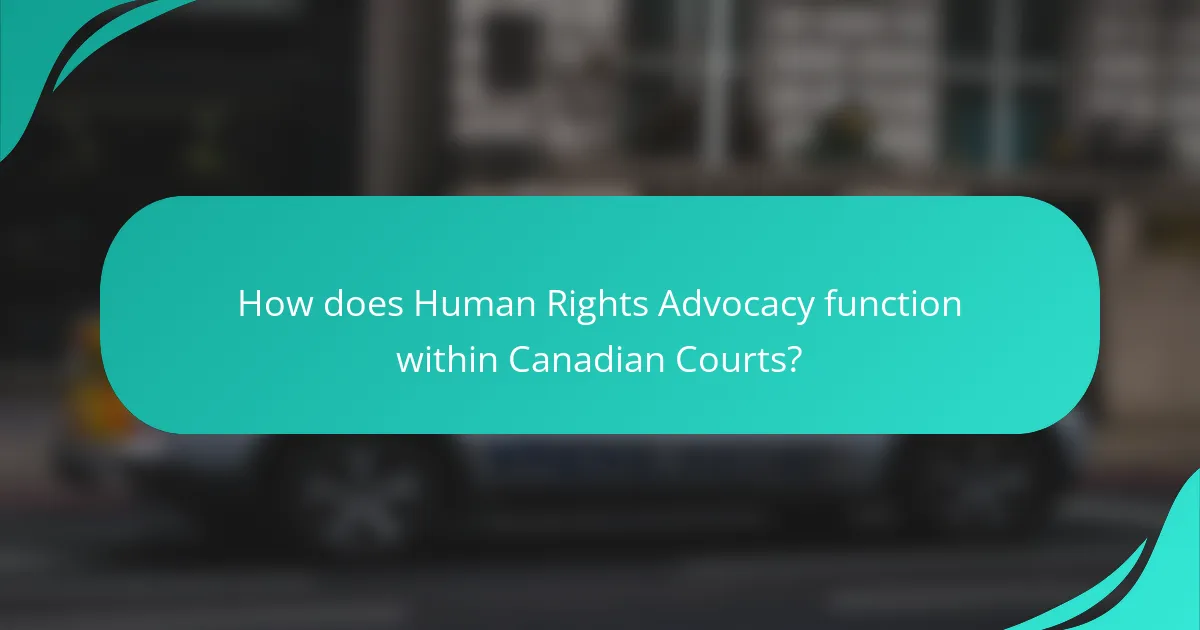
How does Human Rights Advocacy function within Canadian Courts?
Human Rights Advocacy in Canadian Courts functions through legal mechanisms that protect individual rights. These mechanisms include statutory frameworks, such as the Canadian Charter of Rights and Freedoms. The Charter provides a foundation for individuals to challenge laws or actions that infringe upon their rights. Advocacy groups often represent marginalized communities in these legal challenges. They work to raise awareness and provide legal support. Courts interpret and apply human rights laws in their rulings. Landmark cases, such as R v. Oakes, demonstrate the application of the Charter. The judiciary plays a crucial role in upholding human rights through judicial review.
What processes are involved in Human Rights cases?
Human rights cases involve several key processes. The initial step is the filing of a complaint, often by an individual or group alleging a violation. This complaint is typically submitted to a human rights tribunal or commission. Next, a preliminary assessment occurs to determine if the case warrants further investigation. If accepted, the case proceeds to mediation or conciliation attempts to resolve the issue amicably. Should mediation fail, a formal hearing is scheduled where evidence and testimonies are presented. After the hearing, a decision is made by the tribunal, which can include orders for remedies or penalties. Finally, there may be options for appeal if either party disagrees with the decision. These processes aim to ensure fair treatment and accountability in human rights matters.
How are cases initiated and what are the procedural steps?
Cases are initiated in Canadian courts through the filing of a statement of claim or application. This document outlines the nature of the dispute and the relief sought. The plaintiff must ensure the claim is filed in the appropriate court, based on the jurisdiction and the amount in question. After filing, the plaintiff serves the documents to the defendant, notifying them of the legal action.
The defendant then has a specific period to respond, typically by filing a statement of defense. If the case proceeds, both parties may engage in discovery, exchanging relevant information and documents. Pre-trial conferences may occur to facilitate settlement discussions. If unresolved, the case moves to trial, where evidence is presented, and a judge or jury makes a decision.
These procedural steps are governed by the Rules of Civil Procedure in Canada, ensuring a structured approach to legal disputes.
What role do judges and juries play in these cases?
Judges and juries play critical roles in human rights cases in Canadian courts. Judges oversee the legal process and ensure that laws are applied fairly. They interpret the law and make rulings on the admissibility of evidence. Judges also provide instructions to juries about legal standards and the burden of proof.
Juries, when present, are responsible for determining the facts of the case. They assess the evidence presented and decide on the credibility of witnesses. Juries deliver verdicts based on their findings, which can significantly influence the outcome of human rights cases. Their collective judgment reflects community standards and values.
The involvement of both judges and juries helps uphold the integrity of the judicial system. This dual role ensures that human rights are protected and that justice is served in accordance with the law.
What are the outcomes of Human Rights cases in Canadian Courts?
The outcomes of Human Rights cases in Canadian Courts vary widely. Courts may rule in favor of claimants, leading to remedies such as compensation. They can also result in policy changes within organizations or government bodies. Some cases lead to the establishment of legal precedents that shape future interpretations of human rights law. In certain instances, courts may dismiss claims due to lack of evidence or jurisdiction. The Canadian Human Rights Tribunal often handles cases, providing additional avenues for resolution. Overall, outcomes reflect the complexities of legal interpretations and the specific circumstances of each case.
What types of remedies are commonly awarded?
Commonly awarded remedies in human rights cases include damages, injunctions, and declarations. Damages compensate victims for losses suffered due to violations. Injunctions prevent further violations by mandating specific actions or prohibiting certain behaviors. Declarations affirm the rights of individuals and acknowledge breaches. These remedies aim to restore rights and provide justice. Courts often assess the severity of violations when determining the appropriate remedy. The Canadian Human Rights Tribunal frequently issues these remedies in its decisions.
How do these outcomes influence future advocacy efforts?
Outcomes from human rights cases shape future advocacy efforts by providing legal precedents. These precedents inform strategies for addressing similar issues. Successful outcomes can mobilize public support and increase awareness. They also encourage collaboration among advocacy groups. Furthermore, outcomes highlight areas needing reform or further legal challenges. Data from previous cases can guide resource allocation for future initiatives. Advocacy efforts may adapt based on the effectiveness of past approaches. For instance, the Supreme Court of Canada’s decisions often set benchmarks for future cases.
What is the impact of landmark Human Rights cases?
Landmark Human Rights cases significantly shape legal precedents and societal norms. They often lead to changes in legislation, enhancing protections for marginalized groups. For example, the 1982 Canadian Charter of Rights and Freedoms established fundamental rights and freedoms, influencing numerous court decisions. Landmark cases also raise public awareness about human rights issues. They can mobilize grassroots movements advocating for justice and equality. Additionally, these cases often inspire similar legal challenges in other jurisdictions. The outcomes can lead to greater accountability for governmental and institutional actions. Overall, landmark Human Rights cases play a crucial role in advancing civil liberties and social justice.
How have landmark cases shaped public perception of Human Rights?
Landmark cases have significantly influenced public perception of human rights. They serve as pivotal moments that highlight injustices and mobilize public opinion. For instance, the Supreme Court of Canada’s decision in R. v. Morgentaler (1988) decriminalized abortion, reshaping societal views on women’s rights and bodily autonomy. Similarly, the case of Vriend v. Alberta (1998) recognized discrimination based on [censured] orientation, prompting broader acceptance of [censured] rights. These rulings often spark national conversations and encourage activism. They also lead to legislative changes that reflect evolving societal values. Landmark cases thus act as catalysts for change, shaping how human rights are understood and prioritized in Canada.
What precedents have been set by significant rulings?
Significant rulings in Canadian courts have set important precedents for human rights advocacy. For example, the Supreme Court of Canada ruling in R v. Oakes established the Oakes test for determining if a law that limits rights can be justified under Section 1 of the Canadian Charter of Rights and Freedoms. This test is now a fundamental standard in assessing the balance between individual rights and societal interests.
Another notable precedent is the decision in Vriend v. Alberta, which recognized [censured] orientation as a prohibited ground of discrimination under the Alberta Individual Rights Protection Act. This ruling expanded the scope of human rights protections in Canada.
Furthermore, the case of Eldridge v. British Columbia highlighted the duty of governments to provide services in a manner that respects the rights of all individuals, including those with disabilities. This ruling reinforced the principle of equality in access to healthcare services.
These cases collectively illustrate how significant rulings have shaped the landscape of human rights law in Canada. They serve as guiding frameworks for future cases and legislative actions concerning human rights.
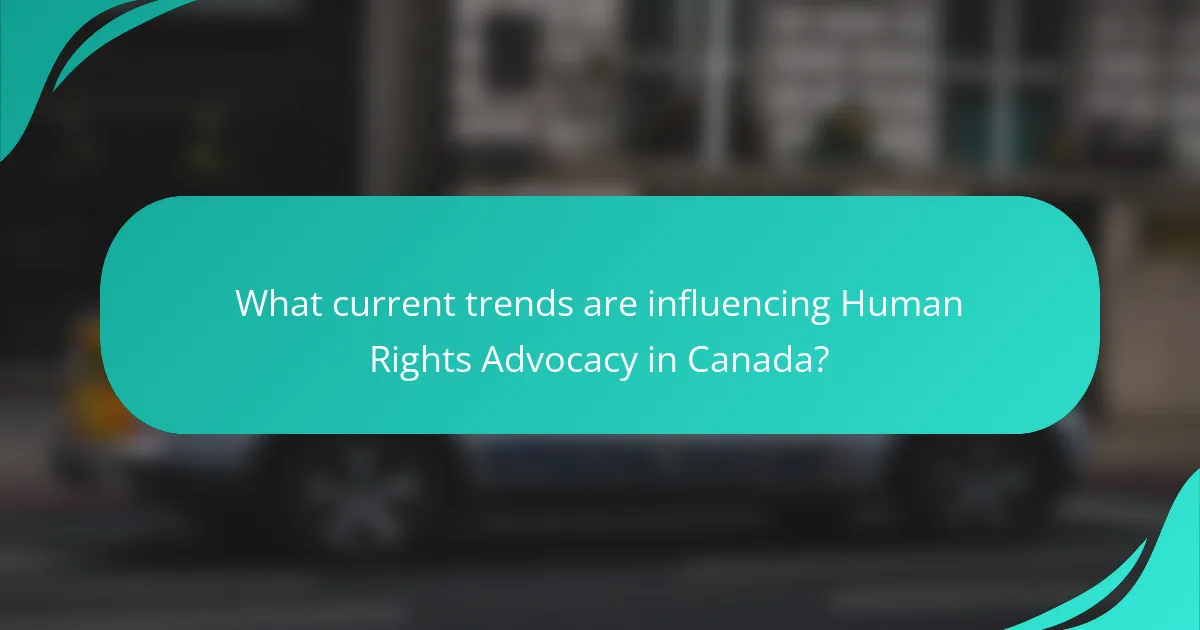
What current trends are influencing Human Rights Advocacy in Canada?
Current trends influencing Human Rights Advocacy in Canada include increased focus on Indigenous rights, climate change, and digital privacy. Advocacy groups are emphasizing the need for reconciliation with Indigenous peoples. This includes addressing historical injustices and land rights issues. Climate change is increasingly recognized as a human rights issue. Activists argue that environmental degradation impacts vulnerable populations. Digital privacy concerns are rising due to increased surveillance and data collection. The demand for stronger privacy protections is growing among citizens. These trends reflect a broader understanding of human rights as interconnected and evolving in response to contemporary challenges.
How is technology changing the landscape of Human Rights Advocacy?
Technology is significantly transforming Human Rights Advocacy by enhancing communication and mobilization. Digital platforms enable activists to reach global audiences instantly. Social media campaigns can raise awareness about human rights violations quickly. Online petitions gather support and signatures from diverse populations. Data analytics tools help track human rights abuses effectively. Furthermore, technology facilitates real-time reporting of incidents. Virtual reality experiences can evoke empathy and understanding of human rights issues. Overall, these technological advancements empower advocates to drive change more efficiently.
What role does social media play in raising awareness?
Social media plays a crucial role in raising awareness about various issues, including human rights advocacy. It provides a platform for individuals and organizations to share information rapidly. This immediacy allows for real-time updates on human rights violations and advocacy efforts. Social media facilitates engagement by enabling users to discuss and share personal experiences. It also amplifies marginalized voices that may not be heard through traditional media. Studies show that campaigns on platforms like Twitter and Facebook can significantly increase public awareness and mobilize support. For example, the #MeToo movement gained global attention through social media, highlighting issues of [censured] harassment and assault. Thus, social media serves as a powerful tool for raising awareness and fostering community action in human rights advocacy.
How are online platforms being used for advocacy and legal support?
Online platforms are increasingly utilized for advocacy and legal support by providing accessible resources and community engagement. These platforms facilitate the dissemination of information regarding legal rights and available support services. They enable individuals to connect with legal experts and advocacy groups through forums and social media. Online petitions and campaigns raise awareness about human rights issues, mobilizing public support effectively. Digital tools allow for the collection of evidence and testimonies, enhancing cases presented in court. Furthermore, platforms like social media amplify marginalized voices, fostering a sense of community among advocates. The use of these technologies has been shown to increase participation in legal processes and advocacy efforts significantly.
What emerging issues are being addressed in Canadian Human Rights Advocacy?
Emerging issues in Canadian Human Rights Advocacy include systemic racism, Indigenous rights, and disability rights. Systemic racism has gained attention due to ongoing discrimination in various sectors. Indigenous rights are increasingly prioritized, especially regarding land and resource management. Disability rights advocacy focuses on accessibility and inclusion in society. Gender identity and [censured] orientation discrimination are also critical areas being addressed. Mental health awareness is rising, highlighting the need for equitable treatment. Climate change impacts on marginalized communities are emerging as a significant concern in advocacy efforts. Recent reports, such as the Canadian Human Rights Commission’s findings, support these issues as areas requiring urgent attention.
How are Indigenous rights being integrated into advocacy efforts?
Indigenous rights are being integrated into advocacy efforts through legal frameworks and collaborative partnerships. Advocacy groups are increasingly utilizing the United Nations Declaration on the Rights of Indigenous Peoples (UNDRIP) as a guiding document. This provides a foundation for legal claims and policy changes. Organizations work alongside Indigenous communities to ensure their voices are prioritized in advocacy initiatives. Legal cases in Canadian courts often reference treaty rights and land claims to support Indigenous positions. Recent rulings have recognized the importance of consultation with Indigenous peoples in resource development projects. This integration fosters a more inclusive approach to human rights advocacy. Statistics show increased success rates for Indigenous-led legal challenges in recent years, highlighting the effectiveness of these integrated efforts.
What challenges do marginalized communities face in accessing justice?
Marginalized communities face numerous challenges in accessing justice. These challenges include systemic discrimination within the legal system. Economic barriers often prevent individuals from affording legal representation. Language barriers hinder effective communication with legal authorities. Additionally, cultural biases can lead to mistrust of law enforcement and judicial processes. Geographic isolation limits access to legal resources and support services. Research indicates that these factors contribute to lower rates of legal advocacy among marginalized groups. For example, a study by the Canadian Bar Association found that Indigenous peoples and racialized communities experience significant disparities in legal outcomes. These challenges collectively impede the pursuit of justice for marginalized communities.
What best practices can enhance Human Rights Advocacy in Canadian Courts?
Best practices that can enhance Human Rights Advocacy in Canadian Courts include comprehensive legal training for advocates. This training ensures that advocates are well-versed in human rights law and court procedures. Regular workshops and seminars can update advocates on recent legal developments. Collaborative approaches among various advocacy groups can strengthen cases and share resources effectively. Utilizing technology for case management and documentation improves efficiency and accessibility. Engaging with affected communities fosters a deeper understanding of their needs and perspectives. Building relationships with legal professionals and judges can promote more favorable outcomes. Finally, public awareness campaigns can highlight human rights issues, encouraging broader support and advocacy efforts.
How can collaboration between organizations improve outcomes?
Collaboration between organizations can improve outcomes by pooling resources and expertise. This approach enhances problem-solving capabilities. For example, partnerships enable sharing of best practices and innovative strategies. Collaborative efforts can lead to more comprehensive advocacy initiatives. Research indicates that joint campaigns often achieve greater visibility and impact. A study by the Harvard Business Review found that cross-sector collaborations can increase efficiency by 25%. Furthermore, collaboration can foster stronger relationships with stakeholders. This results in improved trust and support for initiatives. Ultimately, collective action can drive systemic change in human rights advocacy.
What strategies can advocates employ to increase effectiveness?
Advocates can employ several strategies to increase effectiveness in human rights advocacy. First, they should build strong coalitions with other organizations. Collaborating amplifies resources and strengthens voices. Second, advocates must engage in thorough research to support their claims. Evidence-based arguments are more persuasive in court. Third, effective communication is crucial. Clear messaging helps convey the importance of human rights issues. Fourth, utilizing social media can raise awareness and mobilize public support. Digital platforms enable wider reach and engagement. Fifth, training and capacity-building for advocates enhance skills and knowledge. Well-prepared advocates are more effective in presenting their cases. Finally, advocates should focus on strategic litigation. Targeting specific cases can set important legal precedents. These strategies collectively contribute to more impactful advocacy in Canadian courts.
Human Rights Advocacy in Canadian Courts is the legal effort to protect and promote individual rights as outlined in the Canadian Charter of Rights and Freedoms. This article analyzes the evolution of advocacy, significant historical events, and the legal frameworks that support these efforts. It highlights the objectives of advocacy, the challenges faced by marginalized communities, and the role of organizations in achieving justice. Furthermore, it discusses the impact of landmark cases, current trends, and best practices to enhance advocacy effectiveness within the Canadian legal system.
